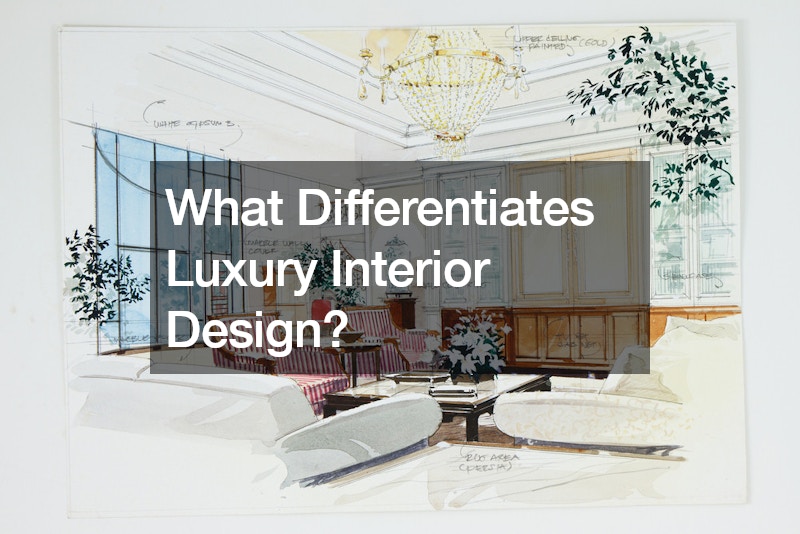Luxury interior design is a realm where artistry, craftsmanship, and exclusivity converge to create spaces that exude sophistication, comfort, and individuality. Distinguishing luxury interior design from standard or mass-market designs involves several key elements that collectively elevate a space to the pinnacle of elegance and refinement. Here are the defining features that set luxury interior design apart.
1. Attention to Detail
Luxury interior design is characterized by an unwavering attention to detail.
Every element, from the intricate moldings and bespoke furniture to the choice of fabrics and finishes, is meticulously selected and crafted. Designers in the luxury sector spend considerable time ensuring that each aspect of the design harmonizes perfectly, creating a cohesive and aesthetically pleasing environment. This meticulous approach often involves custom-made pieces and tailor-made solutions that address specific client needs and preferences.
2. High-Quality Materials
The use of high-quality, often rare materials is a hallmark of luxury interior design. Natural stones like marble and granite, exotic woods, fine leathers, and rich textiles such as silk and velvet are commonly employed. These materials not only enhance the visual appeal but also ensure longevity and durability. The choice of superior materials contributes significantly to the tactile and sensory experience of the space, adding a layer of opulence and comfort.
3. Exclusivity and Personalization
Luxury interior design is inherently exclusive. It often involves limited-edition or one-of-a-kind pieces that are not available to the general market. Personalization is key; luxury designers work closely with clients to create bespoke solutions that reflect their individual tastes, lifestyles, and aspirations. This bespoke approach can extend to every element of the design, from custom-built furniture and lighting fixtures to personalized color schemes and artwork.
4. Innovative and Timeless Design
While trends may influence some aspects of luxury interior design, the focus is typically on creating spaces that are both innovative and timeless. Designers blend contemporary aesthetics with classic elements, ensuring that the space remains stylish and relevant for years to come. This balance between innovation and timelessness often involves the incorporation of cutting-edge technology seamlessly integrated with traditional craftsmanship.
5. Functionality and Comfort
In luxury interior design, functionality and comfort are given as much importance as aesthetics. The layout is meticulously planned to ensure that the space is not only beautiful but also highly functional and comfortable. This might involve ergonomic furniture, smart home technology, and thoughtful spatial arrangements that enhance the flow and usability of the space. High-end luxury spaces often feature state-of-the-art amenities designed to offer maximum comfort and convenience.
6. Artistic Expression
Art plays a crucial role in luxury interior design. Whether through carefully curated collections of fine art, sculptures, or unique installations, art serves as both a focal point and a complementary element to the overall design. The integration of art into the interior design not only enhances the aesthetic appeal but also adds depth and character to the space, reflecting the owner’s personal taste and cultural interests.
7. Sustainability and Ethical Sourcing
Modern luxury interior design increasingly incorporates sustainability and ethical sourcing practices. High-end designers and clients alike are more conscious of the environmental and social impact of their choices. This involves selecting eco-friendly materials, ensuring responsible sourcing of woods and textiles, and incorporating energy-efficient technologies. This commitment to sustainability does not compromise the quality or elegance of the design but rather adds a layer of conscientious luxury.
8. Exceptional Craftsmanship
Exceptional craftsmanship is a defining feature of luxury interior design. The creation of custom furniture, fixtures, and finishes by skilled artisans ensures that each piece is unique and of the highest quality. This level of craftsmanship often involves traditional techniques passed down through generations, combined with modern innovations. The result is a harmonious blend of old-world charm and contemporary sophistication.
9. Strategic Use of Space
Luxury interior design involves a strategic and often innovative use of space. Designers maximize both the functionality and aesthetic potential of the space, often transforming unconventional areas into stunning, usable features. This might include hidden storage solutions, multi-functional furniture, and unique architectural elements that create a sense of grandeur and spaciousness.

